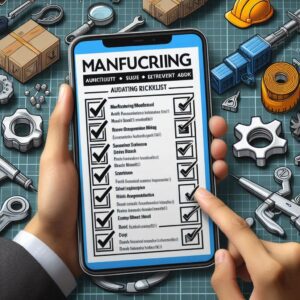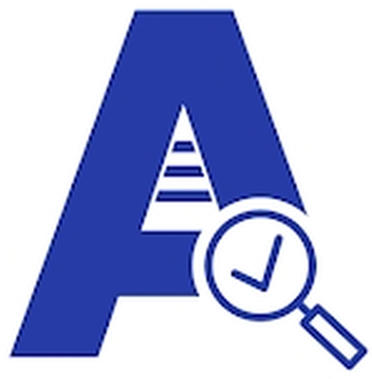Manufacturing Audit Checklist
Creating a Manufacturing Audit Checklist in eAuditor Audits & Inspections will help assess a manufacturer’s operations, ensuring they meet quality standards, safety protocols, and regulatory requirements. Below is a detailed breakdown of sections and questions to include in your checklist.

1. Basic Information Section
This section captures key details:
- Audit Title: Manufacturing Audit
- Audit Date: [Date]
- Conducted By: [Auditor Name]
- Manufacturer Name: [Manufacturer Name]
- Location: [Manufacturing Site Address]
- Contact Person: [Manufacturer Representative]
2. Pre-Audit Information
- Purpose of the Audit: (e.g., initial audit, routine, or follow-up)
- Audit Scope: (e.g., quality control, compliance, health & safety)
- Standards for Audit: (e.g., ISO 9001, GMP, company-specific standards)
3. Quality Management System
- Is there update process in place for procedures and work instructions and is it easily accessible?
- Does facility conduct and document regular internal audits?
- Does the manufacturer have a documented quality management system (QMS)?
- Are corrective actions implemented and monitored?
- Are there clear procedures for managing non-conforming products?
4. Product Design and Development (if applicable)
- Does facility consider customer feedback during product design?
- Are design processes well-documented and controlled?
- Does facility review and approve changes in design before implementation?
- Does facility review prototypes or test models thoroughly before full-scale production?
5. Incoming Material Inspection
- Is there inspection process for incoming materials before acceptance?
- Is there a system for tracking raw materials, parts, or components?
- Are supplier certificates of compliance available for raw materials?
- Is there a documented procedure for handling rejected materials?
6. Production Process Control
- Are production processes documented and standardized?
- Are work instructions available at workstations?
- Is there proper documentation for change control (e.g., process, equipment)?
- Does facility monitor and control process parameters (e.g., temperature, pressure)?
- Does site train employees on operational procedures and machine use?
- Are there preventative maintenance programs for machinery?
7. Workplace Organization (5S / Lean)
- Are tools and equipment organized, labeled, and easily accessible?
- Is the production area clean and free of unnecessary materials?
- Does the design of layout allow for smooth production flow (minimizing travel time)?
- Does site use visual management tools (e.g., boards, signs) to aid operations?
8. In-Process Inspection and Testing
- Does facility conduct in-process inspections at key stages of production?
- Are sampling plans for inspections documented and followed?
- Does site keep records of inspection results?
- Are rejected or non-conforming parts segregated to prevent mix-ups?
9. Finished Goods Inspection
- Are finished products inspections before shipping?
- Does site document product test results?
- Is there a procedure for handling finished goods that do not meet specifications?
- Is there checking of packaging and labeling for accuracy?
10. Equipment Maintenance and Calibration
- Is there a preventative maintenance program in place for production equipment?
- Does facility keep maintenance records for machinery and are they up-to-date?
- Does facility calibrate critical tools and equipment regularly?
- Is there documentation for equipment calibration certificates?


11. Health and Safety
- Are employees trained in health and safety protocols?
- Are emergency exits and procedures clearly marked?
- Is there a system in place to report and investigate accidents or near-misses?
- Are protective equipment (e.g., gloves, helmets) available and used by workers?
- Does site conduct safety inspections regularly?
12. Environmental Compliance
- Is the manufacturer compliant with local environmental regulations?
- Does site manage waste materials (hazardous and non-hazardous) properly?
- Is there a recycling program in place for scrap materials?
- Are emissions, noise, and pollution levels within acceptable limits?
13. Supplier Management
- Does facility regularly audit and evaluate suppliers for performance?
- Does manufacturer maintain supplier list?
- Are supplier certifications (e.g., ISO, CE) up to date?
- Are there quality agreements or contracts in place with key suppliers?
14. Logistics and Warehousing
- Are raw materials and finished goods stored properly (e.g., climate control)?
- Is there a procedure for receiving, storing, and shipping products?
- Are products rotated (e.g., First In, First Out method)?
- Are there adequate stock levels, and is inventory tracking accurate?
15. Traceability
- Is there a system in place to trace materials from suppliers to finished goods?
- Can manufacturing can trace back product batches or lots to raw materials?
- Are serial numbers or lot numbers assigned and documented for traceability?
- Are there documented procedures for recalling defective products?
16. Customer Complaints and Feedback
- Is there a system to log and track customer complaints?
- Does site investigate complaints and identify root causes?
- Does site implement corrective actions based on customer feedback?
- Is customer feedback used to improve products and processes?
17. Training and Workforce Competency
- Is there training in-place for employees for their job roles?
- Is there documentation of training records for each employee?
- Are certifications in place for operators for specialized tasks (e.g., operating heavy machinery)?
- Are there regular training updates or refreshers for employees?
18. Audit Findings and Summary
- Summary of Findings: Major findings, minor findings, and observations.
- Opportunities for Improvement: Areas for enhancing processes or quality.
- Non-Conformities Identified: Brief description of non-conformities found.
- Action Plan: Assign responsibilities for corrective actions and deadlines.
19. Corrective Actions
- Does site document and follow-up corrective actions clearly?
- Are there personnel responsible for implementing actions?
- Is there a deadline for completing corrective actions?
- Does site review the effectiveness of corrective actions?
20. Signatures
- Auditor Signature
- Manufacturer Representative Signature
How to Set Up Manufacturing Audit Checklist in eAuditor Audits & Inspections:


- Create a New Template or Use existing Manufacturing Audit Checklist: Use eAuditor Audits & Inspections to design a custom Manufacturing Audit Checklist form with the sections listed above.
- Form Sections: Add each section of the checklist as a separate part of the form.
- Question Types:
- Use Yes/No questions for compliance checks.
- Add multiple-choice for rating performance (e.g., Excellent, Good, Needs Improvement).
- Include text fields for comments and observations.
- Allow photo attachments to capture evidence of non-conformance or good practices.
- Scoring: Assign weights to different sections depending on their importance (e.g., Quality Management might be weighted more heavily than Workplace Organization).
- Signatures: Add digital signature fields for both the auditor and the manufacturer’s representative.
- Automated Reports: Use eAuditor Audits & Inspection’s built-in reporting tools to generate automatic audit reports once completed.
Manufacturing Audit Checklist will help ensure comprehensive audits of manufacturing processes, identifying areas for improvement, maintaining quality standards, and ensuring compliance with safety and regulatory requirements.
